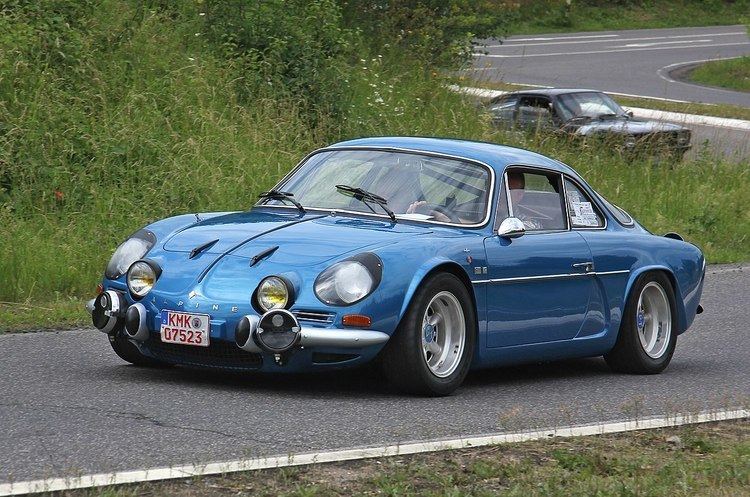Manufacturer Alpine Layout RR layout | Production 1961–77 | |
 | ||
Body style 2-door Coupé (Berlinette) | ||
The Alpine A110 was a sports car produced by the French manufacturer Alpine from 1961 to 1977. The car was described as a "berlinette", a two-door car similar to a coupe. The Alpine A110 was introduced as an evolution of the A108. The A110 was powered by a succession of Renault engines.
Contents
History
Launched in 1961 the A110, like previous road-going Alpines, used many Renault parts including engines. While its predecessor the A108 was designed around Dauphine components, the A110 was updated to use R8 parts. Unlike the A108, which was available first as a cabriolet and only later as a coupé, the A110 was available first with "Berlinette" bodywork and then as a cabriolet. The main visible difference with the A108 coupé was a restyling of the rear body to fit the larger engine, which gave the car a more aggressive look. Like the A108, the A110 featured a steel backbone chassis with fiberglass body. The A110 was originally available with 1.1 L R8 Major or R8 Gordini engines. The Gordini engine delivered 95 hp (71 kW) SAE at 6,500 rpm.
The A110 achieved most of its fame in the early 1970s as a successful rally car. After winning several rallies in France in the late 1960s with cast-iron R8 Gordini Cléon-Fonte engines the car was fitted with the aluminium-block Cléon-Alu from the Renault 16 TS. With two two-venturi Weber 45 carburetors, the TS engine delivered 125 hp (93 kW) DIN at 6,000 rpm. This allowed the production 1600S to reach a top speed of 210 km/h (130 mph). The longer wheelbase 2+2 Alpine GT4, originally considered a version of the A108, was updated with A110 engines and mechanicals, now being marketed as the "A110 GT4".
The car achieved international fame during the 1970–1972 seasons when it competed in the newly created International Championship for Manufacturers, winning several events around Europe and being considered one of the strongest rally cars of its time. Notable performances from the car included victory in the 1971 Monte Carlo Rally with Swedish driver Ove Andersson.
With the buy-out of Alpine by Renault complete, the International Championship was replaced by the World Rally Championship for 1973, at which time Renault elected to compete with the A110. With a team featuring Bernard Darniche, Jean-Pierre Nicolas and Jean-Luc Thérier as permanent drivers and "guest stars" like Jean-Claude Andruet (who won the 1973 Monte Carlo Rally) the A110 won most races where the works team was entered, making Alpine the first World Rally Champion. Later competition-spec A110s received engines of up to 1.8 litres.
As well as being built at Alpine's Dieppe factory, A110 models were constructed by various other vehicle manufacturers around the world. The Alpine A110 was produced in Mexico under the name "Dinalpin", from 1965 to 1974, by Diesel Nacional (DINA), which also produced Renault vehicles. The Alpine A110 was also produced in Bulgaria under the name "Bulgaralpine", from 1967 to 1969, by a cooperative formed between SPC Metalhim and ETO Bulet, whose collaboration also resulted in the production of the Bulgarrenault.
In 1974 the mid-engined Lancia Stratos, the first car designed from scratch for rally racing, was operational and homologated. At the same time, it was obvious that the rear-engined A110 had begun reaching the end of its development potential. The adoption of fuel injection brought no performance increase. On some cars, a DOHC 16-valve head was fitted to the engine, but it proved unreliable. Chassis modification, like the use of an A310 double wishbone rear suspension, homologated with the A110 1600SC, also failed to increase performance. On the international stage, the Stratos proved to be the "ultimate weapon", making the A110, as well as many other rally cars, soon obsolete. The A110 is still seen in events such as Rallye Monte-Carlo Historique.
In 2012, to mark the 50th anniversary of the A110, Renault produced a concept car called the A110-50.
Engines
The A110 was fitted with various powerplants. Here is a list of the engines used on production cars:
Specifications A110 Berlinette (1966)
Engine
Engine: Renault 1108 cc Straight-4
Power output: 98 hp SAE (73 kW) gross; compression ratio 9.6
Chassis/Body
Overall length: 3,851 mm (151.6 in)
Overall width: 1,471 mm (57.9 in)
Height: 1,130 mm (44 in)
Turning circle: 9,246 mm (364.0 in)
Wheelbase: 2,099 mm (82.6 in)
Front track: 1,250 mm (49 in)
Rear track: 1,219 mm (48.0 in)
Empty weight: 544 kg (1,199 lb)
Performance Top speed: 219 km/h (136 mph)
Unique characteristics: due to the rear-mounted engine there was no air-intake grille on the front of the body. Cooling air was scooped from below the chassis and exhausted through near-horizontal openings on the rear fenders above and aft of the rear wheels.
Specifications A110 1600S (1970–73)
Engine
Engine: Renault 1565 cc Straight-4
Power Output: 138 hp SAE (103 kW) gross (125 PS DIN (93 kW))
Transmission
Transmission: 5-Speed Manual
Chassis/Body
Chassis: Steel backbone
Body Panels: Fiberglass
Weight: 620 kg (1,370 lb)
Length: 4,039 mm (159.0 in)
Width: 1,501 mm (59.1 in)
Wheelbase: 2,271 mm (89.4 in)
Track (Front/Rear): 1,219 mm (48.0 in) / 1,250 mm (49 in)
Performance
Top speed: 210 km/h (130 mph)
